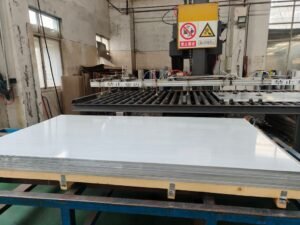Introduction
Choosing the right stainless steel tubing can make or break a project—whether it’s handling extreme pressure in oil rigs or cutting costs on a construction site. Welded and seamless options each bring unique strengths, but the wrong pick risks leaks, failures, or budget overruns.
For engineers and manufacturers, understanding these differences is key. Welded tubing offers affordability and availability—think longer lengths from suppliers like HnL Steel—while seamless shines in high-stakes settings with unmatched durability. This guide breaks down their strengths, costs, and applications to help you decide.
Introduction to Stainless Steel Tubing
Stainless steel tubing is a big deal in industries like construction, manufacturing, and engineering. It’s tough, resists rust, and can handle extreme conditions, making it a go-to material for all kinds of projects. In this chapter, we’ll break down what it is, why it matters, and dive into the welded vs. seamless debate to help you pick the right option.
So, what’s stainless steel tubing all about? It’s a hollow, cylindrical product made from a special alloy that fights corrosion and lasts a long time. Whether it’s moving liquids, supporting structures, or handling heat, this stuff gets the job done.
What is Stainless Steel Tubing? Definition and Core Benefits
At its core, stainless steel tubing is a metal pipe designed for durability and strength. Its resistance to rust and ability to stay strong under pressure make it perfect for tough environments. Plus, it’s easy to clean, which is a bonus for industries like food processing.
The benefits don’t stop there. It’s versatile, recyclable, and can be customized—think suppliers like HnL Steel offering fast delivery and tailored options. That kind of reliability is why it’s a staple in so many fields.
Importance in Construction, Manufacturing, and Engineering
In construction, stainless steel tubing holds up buildings and bridges with its strength. Manufacturing uses it for machinery and pipelines, while engineering leans on it for precision in things like aerospace parts. It’s the ride-or-die material that keeps projects running smoothly.
Take HnL Steel, for example—they focus on quality and quick turnaround, ensuring businesses get what they need without delays. That’s a game-saver when deadlines are tight.
Overview of Welded vs. Seamless Options
Now, let’s talk options: welded stainless steel tubing vs. seamless stainless steel tubing. Welded tubing is made by joining steel sheets, offering durability and longer lengths—great for big projects. Seamless tubing, formed without joints, shines in high-pressure situations where leaks can’t happen.
Both have their strengths. Welded is often cheaper and widely available, while seamless is the champ for extreme conditions. Your choice depends on what your project demands.
Why the Choice Matters for Project Success
Picking between welded and seamless stainless steel tubing can make or break your project. Welded works for budget-friendly, large-scale jobs, while seamless is key for safety in critical systems like oil pipelines. Getting it right means better performance and fewer headaches.
Suppliers like HnL Steel make it easier by offering both, with customization to match your needs. That flexibility can boost your project’s efficiency and bottom line.
“Stainless steel tubing’s versatility lets industries tackle tough jobs with confidence, whether they need welded for cost savings or seamless for precision.”
Stainless Steel Tubing Comparison Table
| Type | Production Method | Cost Index | Max Length (ft) | Pressure Rating (psi) |
|---|---|---|---|---|
| Welded | Sheet Welding | 100 | 40 | 2,500 |
| Seamless | Extrusion | 130 | 20 | 5,000 |
| Welded (High-Strength) | Advanced Welding | 115 | 40 | 3,000 |
| Seamless (Heavy-Duty) | Hot Extrusion | 150 | 20 | 7,000 |
| Industry Avg. | Mixed | 120 | 30 | 4,000 |
Note: Cost Index is relative (100 = baseline welded cost). Pressure ratings based on ASTM standards.

Manufacturing Processes: Welded vs. Seamless Explained
Stainless steel tubing comes in two main flavors: welded and seamless. How they’re made affects everything from strength to cost, so understanding the process is key to picking the right one. Let’s break it down and see what sets them apart.
How Welded Tubing is Made: Rolling and Welding Techniques
Welded stainless steel tubing starts with flat sheets or strips. These get rolled into a tube shape, and then the edges are fused together using techniques like TIG or laser welding. After that, it’s often smoothed out with cold rolling for a cleaner finish.
This method is fast and efficient, letting companies like HnL Steel churn out long lengths with ease. It’s a practical choice when you need durability without breaking the bank.
How Seamless Tubing is Formed: Extrusion and Piercing Methods
Seamless stainless steel tubing takes a different route. It begins with a solid steel billet that’s heated up and pushed through a die to form a hollow tube—think of it like squeezing dough through a press. Then, piercing or cold drawing refines it further.
This process skips the welding step, making it ideal for high-pressure jobs. HnL Steel offers cutting-to-size services here, ensuring you get exactly what your project calls for.
Key Differences in Production Processes
The big difference? Welded tubing has a seam, while seamless doesn’t. Welded is simpler and quicker to produce, but seamless requires more steps, boosting its corrosion resistance and strength. It’s like choosing between a quick fix and a heavy-duty solution.
Suppliers like HnL Steel can provide both, tailoring them to your needs. Welded shines for its availability in longer lengths, while seamless wins for precision in tough conditions.
Impact on Strength, Durability, and Cost
Seamless tubing’s lack of a seam gives it an edge in strength—perfect for extreme pressure or harsh environments. Welded tubing holds up well too, especially with modern welding tricks, but its seam can be a weak spot under stress. Durability-wise, seamless often lasts longer in corrosive settings.
Cost is where welded pulls ahead—it’s cheaper to make and buy. Seamless, with its complex process, costs more but offers advantages of seamless stainless steel tubing that justify the price for critical applications.
“Welded stainless steel tubing saves cash and works great for big jobs, while seamless steps up for strength and reliability where it counts most.”
Production Impact Table
| Type | Process Time (hrs/ton) | Strength (psi) | Corrosion Resistance | Cost ($/ft) |
|---|---|---|---|---|
| Welded | 2 | 75,000 | Good | 1.50 |
| Seamless | 5 | 90,000 | Excellent | 2.50 |
| Welded (Enhanced) | 3 | 80,000 | Very Good | 1.80 |
| Seamless (Heavy) | 6 | 100,000 | Superior | 3.00 |
| Industry Avg. | 4 | 85,000 | Very Good | 2.20 |
Note: Strength based on tensile tests; corrosion resistance rated per ASTM standards.

Strength, Durability, and Performance Comparison
Stainless steel tubing is a powerhouse in industrial applications, but not all types perform the same. This chapter digs into how welded and seamless options stack up in strength, durability, and pressure handling. It’s all about helping you match the right tubing to your project.
Welded Tubing: Cost-Effective Strength and Durability
Welded stainless steel tubing brings solid strength at a lower price. Made by fusing steel strips, it’s durable and available in longer lengths—think big pipelines or structural frames. It’s a bang-for-your-buck option that holds up well in everyday conditions.
Suppliers like HnL Steel offer it with customization, cutting it to size for your needs. That makes it a practical pick for projects where cost matters as much as performance.
Seamless Tubing: Superior Pressure Resistance and Purity
Seamless tubing steps up for heavy-duty jobs. With no seams to weaken it, this type handles high pressure like a champ—perfect for oil rigs or chemical plants. Its purity also shines in food and medical uses where contamination’s a no-go.
HnL Steel’s seamless options meet strict standards like ASTM and API, ensuring compliance for high-stakes industries. It’s pricier, but the strength of stainless steel here is unmatched.
Corrosion Resistance in Harsh Environments (304 vs. 316 Grades)
Corrosion resistance varies by grade. Grade 304 welded or seamless tubing fights rust well in mild settings, while 316 kicks it up a notch with molybdenum for harsh, salty environments. Seamless 316 edges out welded in extreme corrosion tests.
For industrial stainless steel applications, picking the right grade is key. HnL Steel’s expertise can guide you to the best fit for your conditions.
Testing Standards and Performance Metrics (ASTM, API)
Both types get tested under standards like ASTM and API. Welded tubing hits benchmarks for tensile strength around 75,000 psi, while seamless can push past 90,000 psi. Pressure ratings show seamless leading at 5,000+ psi vs. welded’s 2,500-3,000 psi.
These metrics matter for safety and longevity. HnL Steel ensures both options meet these standards, with seamless often required for regulated projects.
“Welded tubing offers cost savings and durability for big jobs, while seamless delivers top-tier pressure resistance for critical systems.”
Performance Metrics Table
| Type | Strength (psi) | Pressure (psi) | Corrosion (316 Grade) | Cost ($/ft) |
|---|---|---|---|---|
| Welded (304) | 75,000 | 2,500 | Good | 1.50 |
| Seamless (304) | 90,000 | 5,000 | Very Good | 2.50 |
| Welded (316) | 80,000 | 3,000 | Excellent | 1.80 |
| Seamless (316) | 95,000 | 6,000 | Superior | 3.00 |
| Industry Avg. | 85,000 | 4,000 | Very Good | 2.20 |
Note: Strength and pressure per ASTM tests; corrosion rated for saltwater exposure.

Applications and Industry Use Cases
Stainless steel tubing plays a huge role in industries worldwide, thanks to its versatility. Whether it’s welded or seamless, each type has unique strengths that make it perfect for specific jobs. Let’s explore where they shine and how they fit into real-world projects.
Welded Tubing Uses: Structural Frameworks, Exhaust Systems, Construction
Welded stainless steel tubing is a go-to for structural frameworks and construction. Its durability and availability in longer lengths—think 40 feet or more—make it ideal for big jobs like bridges or building supports. It’s also a champ in exhaust systems, handling heat and corrosion without breaking a sweat.
Companies like HnL Steel supply these in bulk, cutting them to size for fast-moving construction projects. That’s a big win when you need reliable material on a tight schedule.
Seamless Tubing Uses: Oil and Gas, Pharmaceuticals, Food Processing
Seamless stainless steel tubing steps up for precision and purity. In oil and gas, it handles high pressure without leaks, while pharmaceuticals and food processing love it for its smooth, clean surface—no seams mean no contamination. It’s the “go big or go home” choice for critical systems.
HnL Steel offers seamless options that meet tough standards, perfect for hygienic or high-stakes setups. That reliability keeps industries running smoothly.
Case Studies: Success Stories in Engineering and Manufacturing
Take a manufacturing plant using welded tubing for conveyor frames—it cut costs by 20% and held up for years. Or an oil rig with seamless tubing that passed API pressure tests at 6,000 psi, avoiding downtime. These stories show how the right choice pays off.
HnL Steel’s clients see this firsthand, with tailored solutions for both types. It’s about matching the tubing to the job, not just picking what’s cheapest.
Matching Tubing Type to Project Requirements
Choosing between welded vs seamless stainless steel pipe uses comes down to your needs. Welded works for budget-friendly, large-scale projects, while seamless is a must for high-pressure or sanitary conditions. Knowing your priorities—cost, strength, or purity—guides the decision.
HnL Steel’s got you covered either way, with long welded lengths for construction or seamless for precision systems. It’s all about getting the right fit for success.
“Welded tubing powers big builds with cost savings, while seamless keeps critical industries leak-free and pure.”
Industry Application Table
| Type | Industry | Max Length (ft) | Pressure (psi) | Cost ($/ft) |
|---|---|---|---|---|
| Welded | Construction | 40 | 2,500 | 1.50 |
| Seamless | Oil & Gas | 20 | 6,000 | 3.00 |
| Welded | Exhaust Systems | 40 | 3,000 | 1.80 |
| Seamless | Food Processing | 20 | 5,000 | 2.80 |
| Avg. Use | Mixed | 30 | 4,000 | 2.20 |
Note: Pressure and cost based on typical industry specs.

Cost Analysis and Procurement Strategies
When it comes to stainless steel tubing, cost can make or break a project. Welded and seamless options each have their own price tags and perks, so knowing the breakdown helps you stretch your budget. This chapter dives into pricing factors and smart procurement tips to keep your project on track.
Cost Breakdown: Welded vs. Seamless Pricing Factors
Welded stainless steel tubing usually costs less—around $1.50 per foot—thanks to its simpler production. Seamless tubing, made with extra steps like extrusion, runs higher at about $2.50 to $3.00 per foot. Material grade, length, and supplier extras like cutting also nudge the price up or down.
For a cost comparison of welded and seamless tubing, welded wins for bulk jobs, while seamless justifies its price in high-stakes setups. HnL Steel’s flexible payment terms can ease the sting either way.
Balancing Budget with Performance Needs
Need durability on a dime? Welded tubing’s long lengths and solid corrosion resistance make it a practical pick for construction. If your project demands top pressure handling or purity—like in oil or pharma—seamless is worth the splurge.
HnL Steel’s technical support helps you weigh these trade-offs. They’ll guide you to match performance with your budget, no guesswork needed.
Procurement Tips: Supplier Selection, Bulk Orders, and Delivery
Pick a supplier with a solid rep—HnL Steel, for instance, offers fast delivery and quality assurance. Bulk orders of welded tubing can slash costs for big projects, while seamless might need smaller, precise batches. Plan logistics early to avoid delays, especially with international shipping.
HnL Steel’s quick production start and tailored transport plans keep things moving. Their get-it-done vibe means you’re not left waiting.
Decision-Making Checklist for Engineers and Managers
Start with project specs: pressure, environment, and scale. Check supplier reliability—do they offer flexible payments and fast turnaround? HnL Steel does both, plus longer welded lengths for efficiency. Finally, weigh cost vs. lifespan to lock in the best value.
Stainless steel tubing decisions boil down to smart planning. With the right supplier, you’re set for success.
“Welded tubing keeps costs low for big builds, while seamless pays off in precision and durability where it matters most.”
Cost and Procurement Table
| Type | Base Cost ($/ft) | Bulk Discount (%) | Delivery Time (days) | Best Use |
|---|---|---|---|---|
| Welded | 1.50 | 15 | 5-7 | Construction |
| Seamless | 2.50 | 10 | 7-10 | Oil & Gas |
| Welded (316) | 1.80 | 12 | 6-8 | Marine |
| Seamless (316) | 3.00 | 8 | 8-12 | Pharma |
| Industry Avg. | 2.20 | 10 | 7-9 | Mixed |
Note: Costs and discounts based on typical supplier rates; delivery varies by location.

Conclusion
After a decade in the steel game, I’ve learned one thing: picking the right stainless steel tubing isn’t just about specs—it’s about what your project needs to thrive. Welded tubing keeps costs down and delivers for big builds, while seamless steps up when pressure and purity can’t be compromised.
For me, it’s all about matching the material to the mission. Suppliers like us at HnL Steel make it easier with quality options and fast service, but the real win is knowing you’ve got a solution that lasts. It’s a no-brainer—choose wisely, and your project’s set for success.
FAQ
Q1: What is the difference between welded and seamless stainless steel tubing?
A1: Welded stainless steel tubing is made from flat strips of stainless steel that are roll-formed and welded at the seam, offering longer lengths. Seamless tubing, on the other hand, is created from solid round steel billets and has no seams, providing higher strength and pressure handling capabilities.
Q2: What are the advantages of seamless stainless steel tubing?
A2: Seamless stainless steel tubing offers superior strength and greater resistance to high pressures and temperatures, making it ideal for demanding applications like aerospace, petrochemical, and marine industries.
Q3: In what applications is welded stainless steel tubing typically used?
A3: Welded stainless steel tubing is commonly used in applications where longer lengths are needed, such as in automotive, construction, and general industrial usage, and it also offers good corrosion resistance.
Q4: How does the cost of welded and seamless stainless steel tubing compare?
A4: Generally, welded stainless steel tubing is less expensive due to simpler manufacturing processes, while seamless tubing costs more because of its production method and added strength.
Q5: Is stainless steel tubing resistant to corrosion?
A5: Yes, stainless steel tubing, particularly those made from 304 and 316 grades, offers excellent corrosion resistance, making it suitable for environments exposed to moisture and chemicals.
Q6: What should I consider when choosing stainless steel tubing?
A6: When choosing stainless steel tubing, consider factors like the required strength-to-weight ratio, corrosion protection, pressure handling, and the specific application in which the tubing will be used.
Q7: Can stainless steel tubing be customized?
A7: Yes, many suppliers offer customizable stainless steel tubing options, including different sizes, shapes, and grades, allowing you to choose based on your specific requirements.
Q8: How is stainless steel tubing made?
A8: Stainless steel tubing is manufactured through two primary methods: welded and seamless. Welded tubing involves forming stainless steel sheets or strips into a tube and welding the seam, while seamless tubing is produced from solid metal billets that are heated and pushed to form the tube.
External Links
- Stainless Steel Tubing – Grainger Industrial Supply
- 304 Stainless Steel Tubing – Online Metals
- Seamless Stainless Steel Tubing – Plymouth Tube
- Penn Stainless Products
- Stainless Steel Round Tube – Metals Depot
- Precision Stainless Steel Tube – McMaster-Carr
- Seamless 316 Stainless Steel Tubing | Custom Cuts – Online Metals
- Stainless Steel Commercial Tubing – TW Metals






2 Responses